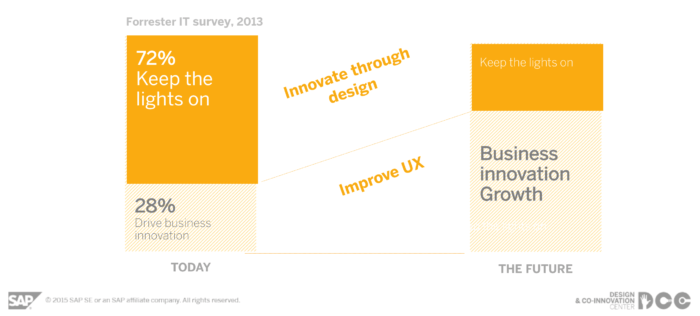your journey
How to Convince IT and Business to Value Design
Good article from SAP helping organisations put a value on design
One of the biggest outcomes of the technology consumerization trend is how it has driven the importance of design. There’s no “waiting out” this trend – an unstoppable wave of interest in design centricity is hitting the business world, shifting the focus in product and service development from features to experience. But why? What is the real value of design? Why is it worth the investment?
Certainly there’s the human value gained through a better designed user experience, including increased user satisfaction, customer loyalty and solution adoption, as well as a stronger relationship between IT and the business. But there is also increasing evidence that design offers measurable monetary value, as well.
According to research conducted by the Design Management Institute, design-drivencompanies maintain a significant stock market advantage, outperforming the S&P by 219% over a 10-year period. In short, good design shows up in the business value of the company. Businesses can also realize measurable results, in the form of increased productivity, lower training and support costs, fewer user errors and a decrease in change requests.
A Forrester IT survey from 2013 found IT leaders estimated they spend an average 72% of their budget on “keep-the-lights-on”, while only 28% of the money goes towards new innovations. CIOs want to re-define the role of IT and invest more money to drive business innovation.

In actuality, design centricity promises both short- and long-term value for a variety of business stakeholders, from the employee level to the CEO. An improved user experience (UX), for instance, can help CEOs meet their short-term goal of boosting revenue, as well as CIOs’ need to reduce costs. A better UX can help business managers boost user satisfaction, and better enable employees to get their jobs done.
An example is Ferrovie dello Stato Italiane where we re-designed its logistics portal to meet the needs of both its customers and suppliers. We achieved a number of objectives, including reducing the number of clicks from 16 to 7, switching to mobile devices to reduce operations costs and receiving a higher acceptance from suppliers and customers.
When the National Hockey League redesigned its online statistics page, it achieved 408,000 unique views in three days and gained more than 18 million Twitter impressions speaking positively about the experience.
Of course, these outcomes are not enough for real marketplace success; CEOs want to achieve market leadership, CIOs want to emphasize innovation, business managers want to beat the competition, and employees want to actually enjoy their work. Innovation through design can help organizations achieve these longer term goals, when it is used to launch real innovations, leapfrogging the competition and disrupting entire marketplaces.
An example is eBay, where we helped market analysts reduce decision-making timeframes from 29 days to one, by using design thinking and the power of SAP HANA to create an entirely new way for them to spot anomalies in online shopping trends.
Another example is the National Center for Tumor Diseases in Heidelberg, Germany, where we combined the power of design thinking with the power of SAP HANA to help the center discover an entirely new way to treat patients and impact peoples’ lives.
Once businesses are convinced of the value of design and design thinking, they can get started on the road to becoming a design-centric organization. Here are a few recommendations for getting there:
- Show the value of design
Leverage the SAP UX value calculator and then comparing that value with the costs to find the ROI. - Start with quick wins
Prove the real value of design improvements. Leverage solutions like SAP Fiori or SAP Screen Personas to show quickly value to your business users. People also need to experience design to understand the impact of a truly strong user experience; it’s not something you can teach. - Get top management buy-in
You need commitment, budget and resources to make it happen. Conduct design thinking workshops with cross-organizational stakeholders, including C-level execs, to let them touch and feel the power of Design. - Adopt the mindset
Design is not an end state but a three-stage process of “discover, design and deliver.” - Build a culture of innovation
within the organization, using the three key ingredients of people, process and space.
In the end, businesses will be able to expand interest in design thinking throughout the organization, creating a culture of innovation and establishing a more effective – and profitable – way of working.
Share this:

Neil ran his first SAP transformation programme in his early twenties. He spent the next 21 years working both client side and for various consultancies running numerous SAP programmes. After successfully completing over 15 full lifecycles he took a senior leadership/board position and his work moved onto creating the same success for others.